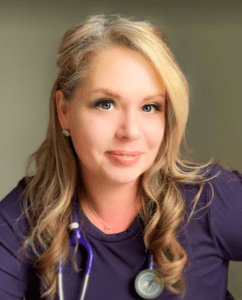As medical and technical advances improve patient care, a new concept is helping the millions of Americans affected by chronic and non-healing wounds. The idea is called Wound Center Without Walls (WCWW). It means providing wound care services outside the physical walls of a wound clinic.

An article published in 2020 in the Wounds journal introduced the idea of providing wound care services outside the traditional brick-and-mortar wound care center.
WCWW untethers wound care from a physical location. Rather, it uses technology and community-centered care to aggressively triage and provide care to patients with wounds.
This new model of providing care was developed in response to the disruptions in healthcare caused by the COVID-19 pandemic. Many patients could not get to their on-site wound clinic appointments due to closures, lock-downs, and fears about leaving home. One study suggested that outpatient wound clinic volume dropped 40% during spring 2020.
In fact, the U.S. experienced rapid telehealth adoption, with an 11,718% increase in telemedicine services among Medicare beneficiaries that year.
Following the pandemic, healthcare providers and patients have realized the value of virtual wound care services. These programs improve access to care and also address the needs of underserved or rural areas where wound specialists may not be available.
Wound care without walls aims to assess and treat patients where they live. This home-based monitoring and treatment strategy may lower risks and improve outcomes.
Telehealth has become an important tool in the management of chronic wounds. Today we have digital tools that are secure, efficient, and easy to use. Mobile apps let patients use their smartphones or tablets to take measurements and send wound images directly to their electronic medical records (EMRs).
Digital imaging tools also give providers more accurate measurements and assessments in many cases. Furthermore, using these tools to optimize wound treatment plans keeps patients and providers engaged.
In cases where a telemedicine consultation is needed, telemedicine providers can meet with patients virtually via video conference. What’s more, with real-time communication, nurses and doctors can even show and tell patients and families:
Telemedicine services are also giving patients treatment reminders and support along the way.
Patients need WCWW because the prevalence of chronic wounds and their healthcare costs are rising. A 2018 study of Medicare beneficiaries found about 8.2 million individuals with wounds.
A large recent study showed that nearly 15% of Medicare beneficiaries presented with a chronic wound or wound infection over a year. Furthermore, Medicare expenditures related to wound care are far greater than previously recognized, with care occurring largely in outpatient settings.
Wounds may result from diabetes, circulatory problems, or pressure injury. Open wounds increase a patient’s risk of infection and need emergency room visits or hospitalization. Specialized wound care treatment is essential to healing wounds quickly with less expense and pain and suffering to the patient.
In short, healthcare providers and patients will surely see an increase in wound care without walls programs. Patients and providers are becoming more comfortable connecting through digital tools, and payers support care that improves outcomes and lowers costs.
Talk with one of our expert doctors if you want to learn more about virtual services or wound care without walls. My Virtual Physician offers video consultations for diabetic, surgical, and other wounds.
Contact us now to find out how you can book your free or low-cost appointment for wound treatment.
Disclaimer: The contents of this article are for informational purposes only and do not constitute medical advice. The information, graphics, and images on this site are not intended to substitute diagnosis or treatment by a medical professional. Always seek the advice of a licensed physician for any questions you may have regarding a specific condition.
"An Economic Evaluation of the Impact, Cost, and Medicare Policy Implications of Chronic Nonhealing Wounds". pubmed.ncbi.nlm.nih.gov. Accessed July 2, 2022.
"Human Wounds and Its Burden". ncbi.nlm.nih.gov. Accessed July 2, 2022.
"Medicare Members Using Telehealth Grew 120 times". healthcaredive.com. Accessed July 2, 2022.
"Outpatient Wound Clinics During COVID-19". ncbi.nlm.nih.gov. Accessed July 2, 2022.
"Telehealth in Wound Care - Evidence and Best Practices". woundreference.com. Accessed July 2, 2022.
"Wound Center Without Walls". ncbi.nlm.nih.gov. Accessed July 2, 2022.
 Sarah Falcone, BSN, RN, WCN-C, CSWD-C, is a certified wound care nurse, nursing consultant, and health content writer in Fort Worth, TX. She works with clients in home health, wound care, and telemedicine. Sarah is a passionate advocate for moving advanced levels of care to the home, where her clients can safely receive the medical treatments they need with greater satisfaction and comfort. She focuses on patient experience, outcomes, and advancing clinical models using innovative technology to serve patients better. Sarah draws from 15 years of practicing patient care and nursing leadership to share her own nursing experiences and expertise online. Connect with her on LinkedIn!
Sarah Falcone, BSN, RN, WCN-C, CSWD-C, is a certified wound care nurse, nursing consultant, and health content writer in Fort Worth, TX. She works with clients in home health, wound care, and telemedicine. Sarah is a passionate advocate for moving advanced levels of care to the home, where her clients can safely receive the medical treatments they need with greater satisfaction and comfort. She focuses on patient experience, outcomes, and advancing clinical models using innovative technology to serve patients better. Sarah draws from 15 years of practicing patient care and nursing leadership to share her own nursing experiences and expertise online. Connect with her on LinkedIn!
Telemedicine provides a convenient way to get the care you need without traveling to the doctor or specialist you need. Virtual care, or Telehealth, has been around for a while, but recent changes in healthcare have caused telemedicine services to surge.
In the past, telemedicine visits were used primarily as urgent care encounters. If you had symptoms of a cold, you could chat with a Tel-a-doc and maybe get antibiotics.
Today, telemedicine services have expanded. And patients can see their telemedicine doctor for gynecologic, primary, and even wound care. In this post, we will look at how telemedicine has become a solution for patients with chronic or non-healing wounds by answering these questions.
Read on to learn more about telemedicine as a wound care solution.
Telemedicine is a healthcare delivery model that involves virtual consultations between patients and physicians, using online tools such as video conferencing, virtual examination rooms, and remote medical devices.
In many situations, telemedicine is ideal for individuals with wounds.
Those injured or struggling with chronic wounds may not feel like leaving home. Or they may be physically unable to leave home without assistance.
Often their caregivers work and cannot take time from work for frequent doctor appointments. Also, depending on where an individual lives, there may not be a wound specialist in the area. If there is a local certified wound care expert, they may have limited availability.
So, wound care appointments may be difficult to get.
Telemedicine providers with specialized training and certification in wound care can save patients and their families frequent trips to their doctor or wound clinic. Telemedicine for wound care is efficient. Doctors can conduct virtual visits, see the wounds, and make treatment recommendations through video.
Telemedicine also lets patients have virtual follow-up conversations with their doctors and send images when the wounds change.
Telemedicine decreases costs by reducing the need to travel long distances to the hospital or to consult with a physician. It improves the quality of life for patients with chronic wounds while maintaining high standards of wound care.
Since the COVID-19 pandemic, federal and state programs (Medicare and Medicaid) and private insurers have expanded coverage for telemedicine services, including wound care.
That is good news for patients with wounds who need to see a specialist. In many cases, your health insurance will cover the cost of your virtual visit and wound care supplies that your provider orders.
Your insurance may cover a virtual doctor visit for treatment if you have:
You can check with your insurance company to find out what they will cover or talk with a telemedicine provider and have them verify your insurance coverage before making an appointment.
Wound care specialists provide a variety of services through telemedicine. According to the Department of Health and Human Services, Telehealth services are especially helpful for monitoring and improving ongoing health issues, like chronic wounds.
A telemedicine wound care specialist can evaluate and treat wounds virtually by:
These services help patients get the right treatment to heal the wound quickly and return to normal lives.
Telemedicine specialists also coordinate your care with your other doctors or home health.
There are many advantages of using telemedicine wound care services, including:
It’s easy to see why telemedicine wound care services are growing.
While there are numerous benefits of telemedicine for patients, primary among them is the ease of convenience and the ability to access quality care fast. Wound care services provided through telemedicine are a great example of a wound care solution that is helping many individuals get the care they need.
If you have a skin wound that needs medical attention, talk with the My Virtual Physician team to find out if their telemedicine wound care services are right for you.
Contact us now for your low-cost appointment that your insurance may cover!